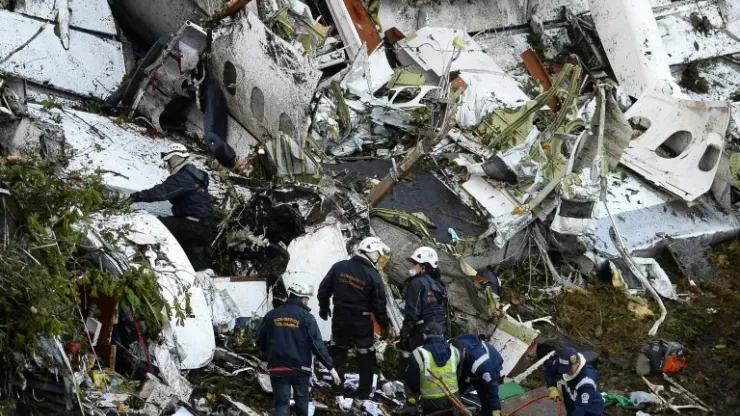La Unión (Colombia) (AFP) – The football world was plunged into mourning Tuesday after a plane carrying a Brazilian team crashed in the mountains in Colombia, killing 75 people with six survivors, officials said.
Football legends Pele and Maradona as well as current superstar Lionel Messi led tributes to the players of Chapecoense Real.
Having risen only recently from obscurity, the team was on its way to play in the finals of the Copa Sudamericana, South America’s second-biggest club tournament when the accident took place.
“The pain is terrible. Just as we had made it, I will not say to the top, but to have national prominence, a tragedy like this happens,” club vice-president Ivan Tozzo told Globo SportTV.
“It is very difficult, a very great tragedy.”
Colombia’s civil aviation authority said in a statement that 75 people were killed in the crash and six survivors were being treated in hospital.
– ‘Electrical failures’ –
The charter plane of Bolivian company LAMIA, which left from the Bolivian city of Santa Cruz, declared an emergency at around 10:00 pm Monday (0300 GMT Tuesday).
It reported “electrical failures” and crashed a short time later near the city of Medellin, its destination, officials said.
The British Aerospace 146 airliner was first sold as new in 1999 and was used by two other airlines before being eventually acquired by LAMIA, a spokesman for the manufacturer told AFP.
Aircraft tracking website Planespotters said it was sold to LAMIA in 2013.
Specialist sites revealed that the same plane was used two weeks ago to fly the Argentine national team with Messi on board to San Juan, Argentina for a World Cup qualifying match.
Britain’s Air Accidents Investigation Branch said it was sending investigators along with representatives of the plane’s manufacturer BAE Systems to Colombia to help with investigations.
– ‘Disastrous scene’ –
Scores of rescuers picked through the wreckage of the white fuselage which was plastered over a remote hillside in northwestern Colombia.
The plane went down about 50 kilometers (30 miles) from Medellin, the country’s second largest city, in an area called Cerro Gordo.
Elkin Ospina, the mayor of the town of La Ceja near the crash site, said the mountainous terrain was some 3,300 meters (10,800 feet) above sea level and very difficult to access.
“We found ourselves faced with a disastrous scene. The plane was completely destroyed,” fire service captain Elkin Gonzalez told AFP.
In all, there were 72 passengers and nine crew on board, including the team and numerous journalists going to cover the game.
Rescuers and aviation authorities said the survivors were three players, two crew members and a journalist.
“I have just seen the plane and given the state it is in, it is a miracle that six people survived,” said the governor of the surrounding Antioquia region, Luis Perez.
The survivors included three players: defenders Helio Neto and Alan Ruschel and another goalkeeper, Jakson Follmann.
The other known survivors were two crew members and a journalist.
The team’s goalkeeper Marcos Danilo Padilha, 31, died on the way to hospital, the civil aviation authority said.
His last-minute save in the semi-final had ensured the team made it through to the Copa Sudamericana final.
– Game suspended –
The cup final first-leg had been scheduled for Wednesday against Atletico Nacional of Colombia.
In an emotional gesture, Nacional called in a statement for the title to be handed to its Brazilian opponents in tribute.
It asked of CONMEBOL “that the Copa Sudamericana title be handed to Chapecoense Football Association as an honorary trophy for its great loss, and as a posthumous homage to the victims of the fatal accident that has put our sport in mourning.”
Regional football confederation CONMEBOL suspended the game. It had yet to announce how the title would be settled.
A source close to CONMEBOL told AFP it was “very unlikely” that the final would ever be played.
Brazil’s President Michel Temer declared three days of mourning for the victims.
– Dashed dreams –
Chapecoense is seen as one of the minnows of Brazilian club football.
It was founded in 1973 in the city of Chapeco in southern Santa Catarina state.
After decades in the lower divisions, Chapecoense returned to Brazil’s top flight Serie A in 2014 for the first time since 1979.
The mayor of Chapeco, Luciano Buligon, described the city’s despair, in tearful comments to TV Globo.
“We have moved from a dream to a true nightmare,” he said.
200+ Channels With Sports & News
- Starting price: $33/mo. for fubo Latino Package
- Watch Premier League, Women’s World Cup, Euro 2024 & Gold Cup
The New Home of MLS
- Price: $14.99/mo. for MLS Season Pass
- Watch every MLS game including playoffs & Leagues Cup
Many Sports & ESPN Originals
- Price: $10.99/mo. (or get ESPN+, Hulu & Disney+ for $14.99/mo.)
- Features Bundesliga, LaLiga, Championship, & FA Cup
2,000+ soccer games per year
- Price: $5.99/mo
- Features Champions League, Serie A, Europa League & Brasileirāo
175 Premier League Games & PL TV
- Starting price: $5.99/mo. for Peacock Premium
- Watch 175 exclusive EPL games per season






